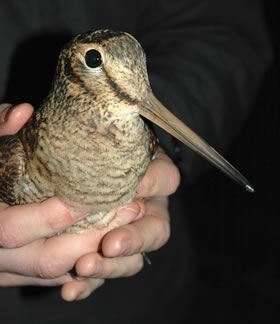 Here on the Woodcock Watch blog we often emphasise the contribution ringing can make to the study of birds (for instance here and here. Given the wealth of technology available to the modern ornithologist it’s often easy to forget the invaluable contribution made by this relatively simple tool.
Here on the Woodcock Watch blog we often emphasise the contribution ringing can make to the study of birds (for instance here and here. Given the wealth of technology available to the modern ornithologist it’s often easy to forget the invaluable contribution made by this relatively simple tool.
Last week, for instance, whilst on the first of our two annual Cornish woodcock-catching trips, Andrew recaptured a woodcock that we first ringed as an adult in 2014. This bird was hatched in the spring/summer of 2012 or earlier meaning that it is now at least three and a half years old.
Andrew recaught it in the same field that it was originally ringed in two years ago. Andrew also caught this bird in 2015, on a neighbouring field, only a couple of hundred metres away. Repeatedly recapturing this bird tells us something interesting about its instinct to return to the same wintering site year after year.
It also provides data which can be used to estimate the survival rates of woodcock or even provide an estimate of the local wintering population size (in essence, an advanced form of ‘Mark and Recapture’.
As well as woodcock, the Woodcock Watch team occasionally ring other species – the details of which are submitted to the BTO for inclusion in the national ringing scheme’s dataset. Each year we usually ring a couple of golden plover; a bird which gives our beloved woodcock a run for its money as a wader with charisma.
Nationally, the number of recaptures for this species is very low. This is mainly down to the fact that relatively few golden plovers are caught each year and subsequently only a small proportion of the population are ringed.
Last week we managed to catch five golden plover; it is rare for us to ring more than this in a single year. Incredibly, however, one of the birds we caught was already ringed! A quick look through the records shows that it is a bird that we ringed the previous year in a field very nearby. Like some of our woodcock, this plover is clearly faithful to this particular wintering site.
The chances of recapturing a ringed golden plover were always slim but the fact we did highlights just why it is worth the effort. These are the sort of records that really inspire our enthusiasm for this kind of work.
Receiving news of ringed birds, whatever the scenario or species, is essential to the ringing scheme. For each of those ringed birds that we recapture there will be many that we don’t. If you come across a ringed woodcock – whether a shot bird, a window-strike or by any other means – please be sure to report it via the Euring website.
Please help our declining UK woodcock